9 Types of Black Birds in Wyoming (With Pictures)
Last Updated on
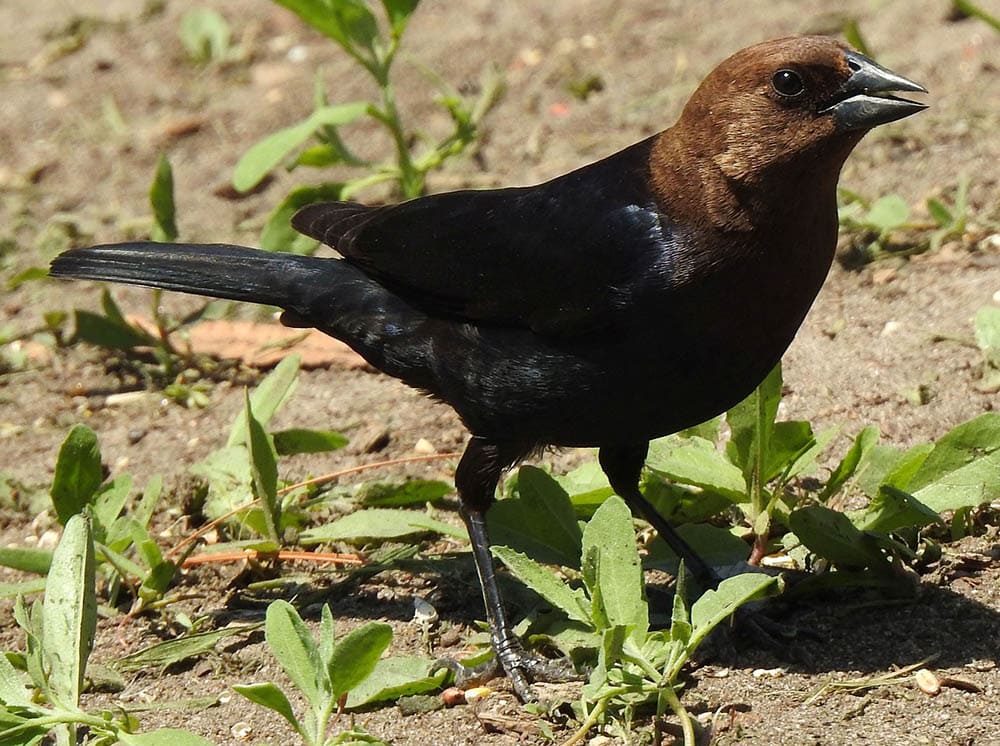
Wyoming has always been special—the pioneer museums, hot springs, and cowboy towns, not to mention its diverse wildlife and national parks.
Today, we want to look at the black bird species that felt this state had everything they needed to not only propagate but also survive.
Before getting into that, it’s important to note that we have a total of 25 different blackbird species that are native to North America. Unfortunately for us, not all of them are regularly occurring in Wyoming, and some are rare and regarded as near-threatened.

The 9 Types of Black Birds in Wyoming
1. Rusty Blackbird
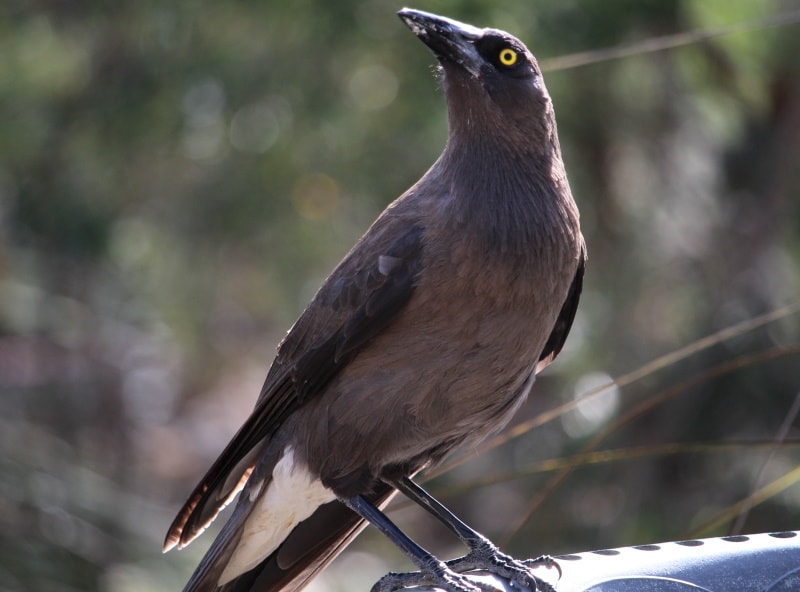
| Weight: | 1.7 – 2.8 oz (47 – 80 g) |
| Length: | 8.3 – 9.8 in (21 – 25 cm) |
| Wingspan: | 14.6 in (37 cm) |
The rusty blackbird population is on a rapid decline. In fact, according to the current stats, their populations have reduced by approximately 80% to 95% over the past 40 years.
We cannot say what exactly is causing this chronic decline, but it likely has something to do with the rapid degradation of wooden wetlands—their natural habitats.
If you’d like to help do something about that, join the International Rusty Blackbird Working Group. They are currently working on projects that would assist to ameliorate the situation.
Both the males and females have shades of rust on their feathers. But the only difference is, the ladies are charcoal gray while their spouses are glossy black. If you don’t have a keen eye, you’ll easily confuse them for the Common Grackle and Brewer’s Blackbirds.
2. Common Grackle
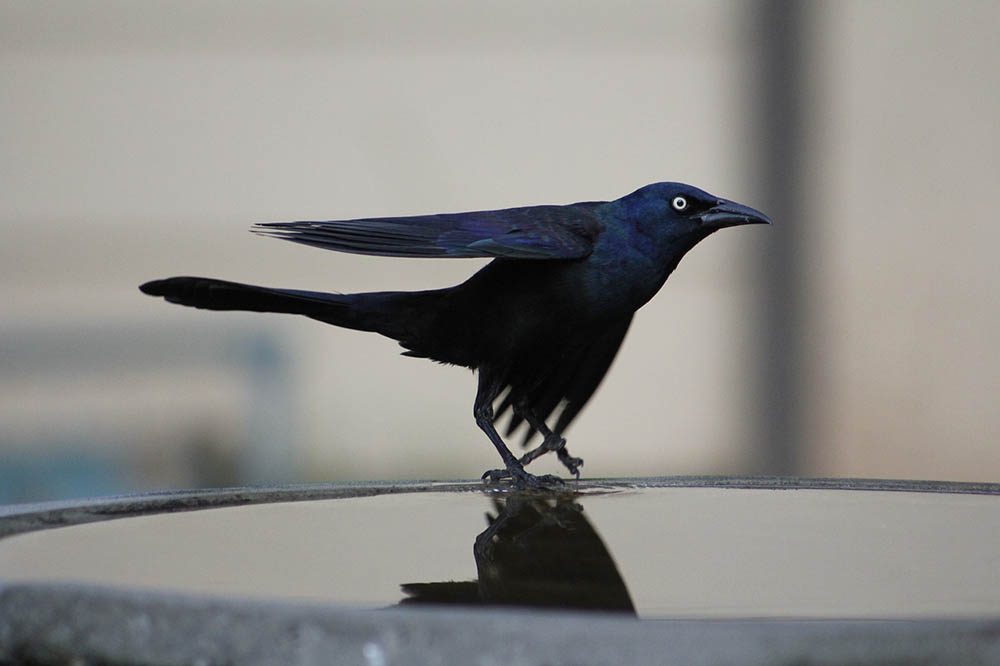
| Weight: | 2.6 – 5.0 oz (74 – 142 g) |
| Length: | 11.0 – 13.4 in (28 – 34 cm) |
| Wingspan: | 14.2 – 18.1 in (36 – 46 cm) |
This species’ invasive behavior is the reason why many people aren’t fond of them. So much so that they’ve decided to call a group of grackles the “Annoyance of Grackles.” Some even go by the “Plague of Grackles.”
Nonetheless, that doesn’t mean that they don’t play any vital roles in our ecosystem. They are valuable prey to a number of animal species, including the hawks, coyotes, owls, and red foxes.
They are also predators and the best remedy for backyard birders looking to control ant populations, blackflies, or mosquitoes.
Grackles are one of the many animals that have helped us populate the planet with millions of plants through seed dispersion. They’ll eat the seeds, digest them, and then release the ones that couldn’t be absorbed. Those droppings are the reason why some plants are found in areas that aren’t typically described as their natural habitats.
3. Brewer’s Blackbird
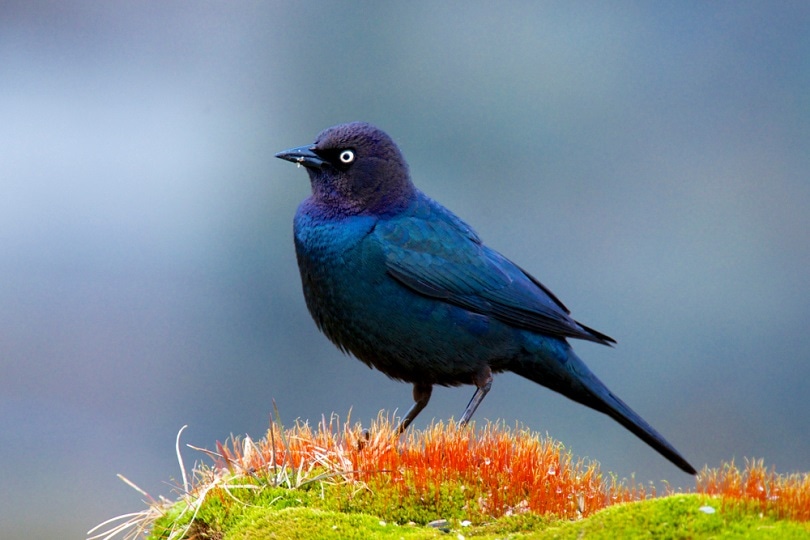
| Weight: | 2.1 – 3.0 oz (60 – 86 g) |
| Length: | 8.3 – 9.8 in (21 – 25 cm) |
| Wingspan: | 14.2 – 18.1 in (36 – 46 cm) |
We like to call these birds the “Parking Lot Birds.” And no, it’s not because they have cars, but because they love interacting with humans as they impudently seek handouts. So, if you’d like to see one just hang around picnickers or parking areas. They’ll be there feeding on the crumbs left behind, while snacking on the flying insects that are oblivious of the danger that lurks around.
The brewer’s blackbird is one of the cousins to the grackle. It belongs to the Icteridae family, meaning you’ll also find some of its genetic markers in a meadowlark or oriole. That also means they prefer nesting in colonies, just like all the other member species of that family. They prefer building nests in shrubs and tree cavities that are closer to the ground, and near a water body.
It’s easy to tell apart the grackle and the brewer’s blackbird just by looking at the tails—that of the latter is relatively shorter. The females are drab in color, but males have an iridescent purple-greenish plumage. Their bright yellow eyes are also a distinguishing feature.
4. Yellow-Headed Blackbird
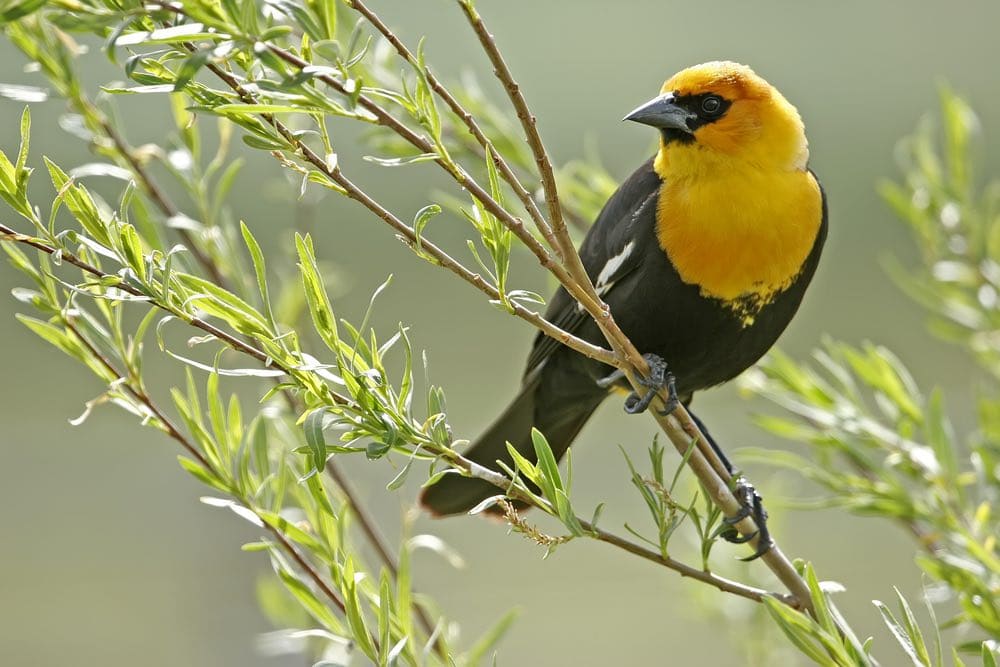
| Weight: | 1.6 – 3.5 oz (44 – 100 g) |
| Length: | 8.3 – 10.2 in (21 – 26 cm) |
| Wingspan: | 16.5 – 17.3 in (42 – 44 cm) |
There’s a very high probability that you’ll find a yellow-headed blackbird nest in a red-winged blackbird’s marsh. And if you’re wondering why our red-winged friend keeps on abandoning its breeding ground whenever the yellow-headed species shows up, it’s because they often feel oppressed and bullied.
These birds are not just hostile to the red-winged species, as we’ve witnessed them act aggressively towards marsh wrens as well. But in the case of the wrens, we understand—we wouldn’t want to hang around birds that are notoriously known to destroy other species’ eggs.
The male yellow-headed bird is usually tasked with the responsibility of protecting the territory. And they are good at it, seeing as they can attract up to eight females in a nesting colony. They’ll also assist their spouses to feed the babies from time to time.
It’s not unusual to find a yellow-headed nestling struggling in some vegetation all alone. Since this species prefers to build its nest over water, the hatchlings sometimes fall in and are forced to swim to the nearest vegetation to survive.
To identify the yellow-headed bird, all you have to do is take note of the color of its head. Needless to say, it’s called “yellow-headed” for a reason.
5. Great-Tailed Grackle

| Weight: | 3.7 – 6.7 oz (105 – 190 g) |
| Length: | 15.0 – 18.1 in (38 – 46 cm) |
| Wingspan: | 18.9 – 22.8 in (48 – 58 cm) |
Winter is the best time to go birding if you’re only interested in studying or being entertained by the great-tailed grackle. In flocks of about half a million, they’ll gather in what ornithologists like to call “roost trees,” to conserve energy.
It’s safe to assume the great-tailed grackle population has exponentially grown over the past couple of years. Since they love spending most of their time in agricultural fields, we believe urban development and the spread of irrigated agriculture could have contributed to this rise.
In terms of food consumption, this grackle variety consumes relatively less food. Male chicks are less likely to survive and get to the fledgling stage. Even when they do, they rarely outlive their sisters. Consequently, resulting in a sex-biased population—the male numbers are lower than that of the females.
The great-tailed grackle is one of the few bird species that can hunt on land or water. So, if you see them hunt insects one minute and frogs the next, don’t be surprised. Some people still believe that this species is the boat-tailed grackle, but there’s still no sufficient evidence to come to that conclusion.
6. Bobolink

| Weight: | 1.0 – 2.0 oz (29 – 56 g) |
| Length: | 9 – 8.3 in (15 – 21 cm) |
| Wingspan: | 10.6 in (27 cm) |
This particular songbird often covers about 12,500 miles every season, during migration. If that doesn’t impress you, this definitely will—as reported by various experts, in a lifetime, the bobolink covers approximately 4 to 5 times the distance of our planet’s circumference!
In the Spanish community, it’s called the “Tordo Charlatan.” The French know it as the “Goglu des pres,” but our scientists prefer oryzivorus. That loosely translates to “rice eater” because the bird has an insatiable appetite for rice and several other grains.
Bobolinks can orient themselves with our planet’s magnetic field. Zoologists believe that it’s the olfactory bulb and the bristles in their nasal cavity that aid them in that process. We also learned that they are intelligent enough to use constellations to guide them during their travels.
It’s not easy for an untrained eye to identify a bobolink, as they molt twice per year. The winter plumage will never be the same as the breeding one. In the cold season, the male feathers will have yellow tips. But as they approach the breeding season, that color starts to wear off, being replaced by black and white colors.
Bobolinks are diurnal but they’ll feed at night if they feel the need to build fat reserves. This is especially true during migration, as the journey is usually taxing to their bodies. They are not just polyandrous, but polygynous as well. Meaning, both the males and females have several mates per breeding season.
7. Red-Winged Blackbirds
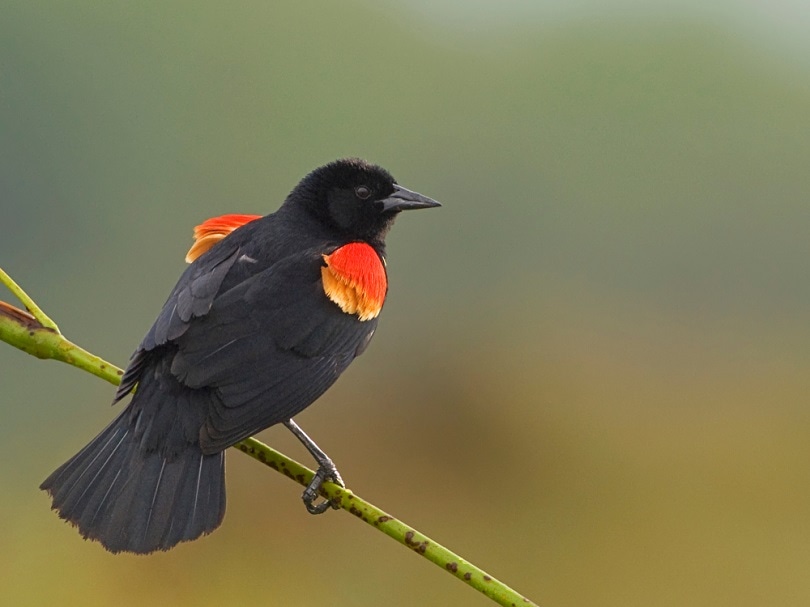
| Weight: | 1.1 – 2.7 oz (32 – 77 g) |
| Length: | 6.7 – 9.1 in (17 – 23 cm) |
| Wingspan: | 12.2 – 15.8 in (31 – 40 cm) |
If there ever was a species that’s synonymous with spring, it would be the red-winged blackbird. And they’ll do anything to be noticed, including belting out their trademark conk-la-ree song.
Identifying the males is easy, as they match the description of the species—“red-winged.” The females might fool you, though. As nature would have it, they had to be different to make it easier for the males to identify mates. They aren’t black, and don’t have any red badges on their shoulders or wings.
In fact, females look like a totally different species, with a dark-brown streaked appearance. What’s more, unlike the boys, they like to maintain a low profile. You’ll rarely catch them making calls, especially during spring or summer.
Behavior-wise, the males are a lot more aggressive than the females. But only once they’ve attracted a mate. A sign that they’re taking up the responsibility of protecting their families seriously.
If a red-winged bird dives at you for no reason, you’ve inadvertently invaded its territory. There’s probably a nest nearby, and you’re regarded as a threat.
8. European Starlings
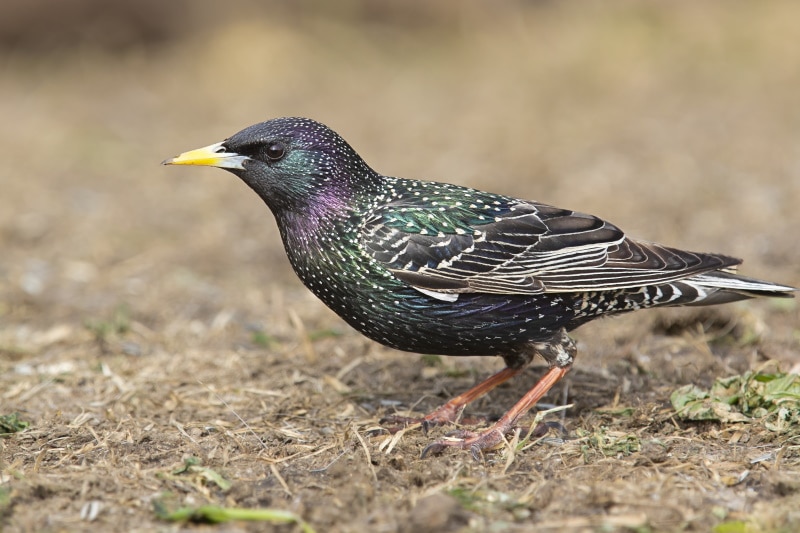
| Weight: | 2.1 – 3.4 oz (60 – 96 g) |
| Length: | 7.9 – 9.1 in (20 – 23 cm) |
| Wingspan: | 12.2 – 15.8 in (31 – 40 cm) |
European starlings are bullies and take over the feeders in gardens. Funny thing is, they’ll never attack one of their own. They are only aggressive to species that don’t belong to their family.
They are called European starlings because they are native to Europe. They weren’t seen much in the US until 1890 when Eugene Schieffelin released 60 different starling species in Central Park, New York City.
Eugene was a German immigrant and for some reason, he felt it was important to introduce all the bird species talked about in the various works of Shakespeare to North America. The starling variety does make a cameo appearance in the play “Hotspur.”
While identifying the European starling, your focus should be on the wings and the tail. The wings will sort of look translucent while they are flying and the tails are square-shaped. Both the males and females have glossy plumage, but their degree of glossiness differs. The dotted plumage will only appear during winter and disappear immediately after the hot weather sets in.
9. Brown-Headed Cowbird
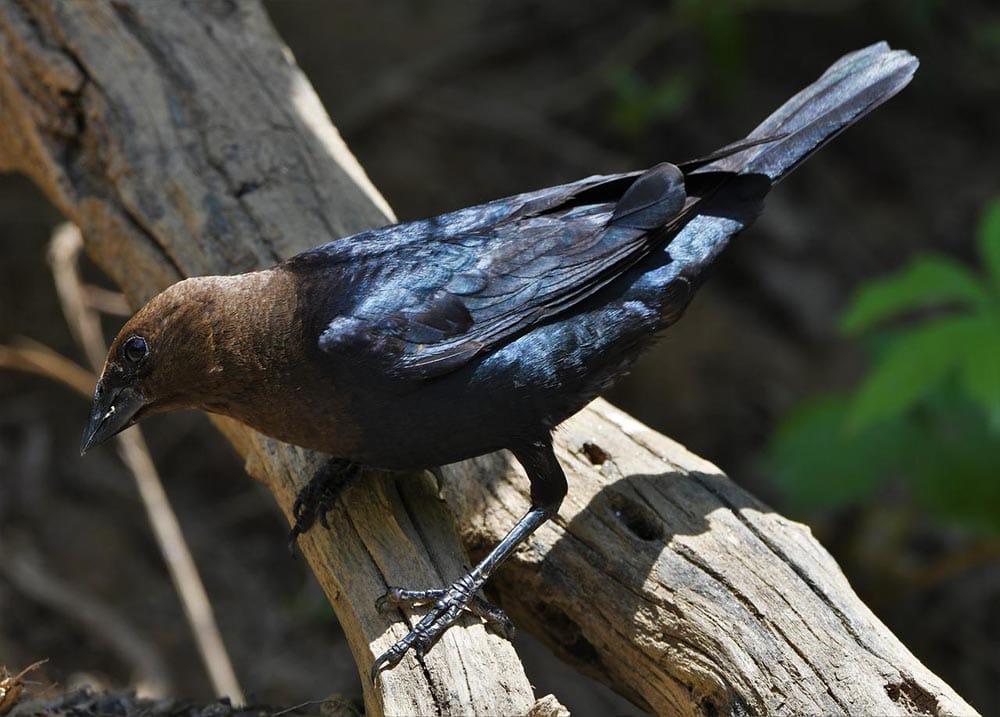
| Weight: | 1.5 – 1.8 oz (42 – 50 g) |
| Length: | 7.5 – 8.7 in (19 – 22 cm) |
| Wingspan: | 14.2 in (36 cm) |
The brown-headed cowbird has hacked the practice of childcare to make it hassle-free. They practice what we call brood parasitism, a method whereby all the bird does is lay eggs in the nest of a different species, cross their fingers, and hope the eggs survive to grow to fully-fledged adults.
Brood parasitism is something that we’ve observed in several other animals, but the brown-headed species has perfected the craft. Some birds are intelligent enough to notice their eggs are different, but they rarely do anything. Those that do, will either push the eggs out of the nest, break them, or abandon their breeding homes.
Ornithologists have a working theory to explain this behavior. They think these birds developed this practice in order to reduce the high rates of nest predation. Ostensibly, they were targets for most predators in the ecosystem.

How Do You Lure Black Birds to Your Garden?
It’s easy to convince these black birds to pay you a visit once in a while, or even build a home in your backyard.
- Make sure your garden is home to different insects because they love snacking on those.
- Fill up your empty feeders with nuts, millet, and cracked corn.
- If you can gain access to nectar, include that as well.
- Offer them fresh water for bathing and drinking.
- Serve them fruits and berries.

Conclusion
There you have it! Nine types of black birds in Wyoming. Trying to lure birds that are anti-social or territorial is a bad idea. They’ll chase all the other friendly species away, eat whatever you have to serve, and leave you feeling lonely. And the thing about birds is that most of them have incredible memory. So, chances are high that the original occupants won’t ever come back.
Featured Image Credit: Bernell, Pixabay
About the Author Robert Sparks
Robert’s obsession with all things optical started early in life, when his optician father would bring home prototypes for Robert to play with. Nowadays, Robert is dedicated to helping others find the right optics for their needs. His hobbies include astronomy, astrophysics, and model building. Originally from Newark, NJ, he resides in Santa Fe, New Mexico, where the nighttime skies are filled with glittering stars.
Related Articles:
Monocular vs Telescope: Differences Explained (With Pictures)
10 Types of Hummingbirds in Arkansas (With Pictures)
8 Types of Hummingbirds in Nebraska (With Pictures)
5 Types of Hummingbirds in Idaho (With Pictures)
3 Types of Hummingbirds in Mississippi (With Pictures)
8 Types of Hummingbirds in Kansas (With Pictures)
5 Types of Hummingbirds in West Virginia (With Pictures)
5 Types of Hummingbirds in Ohio (With Pictures)
